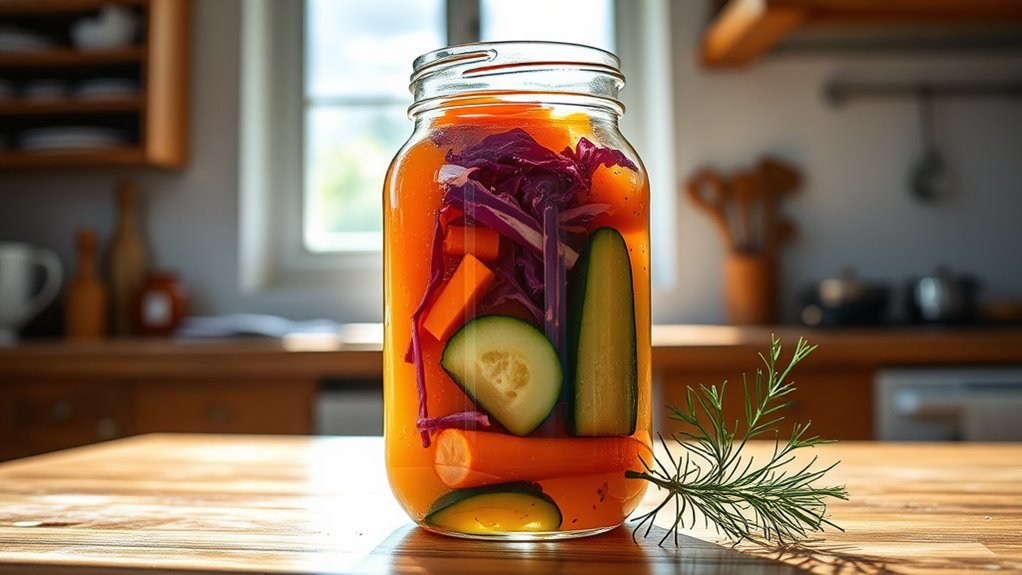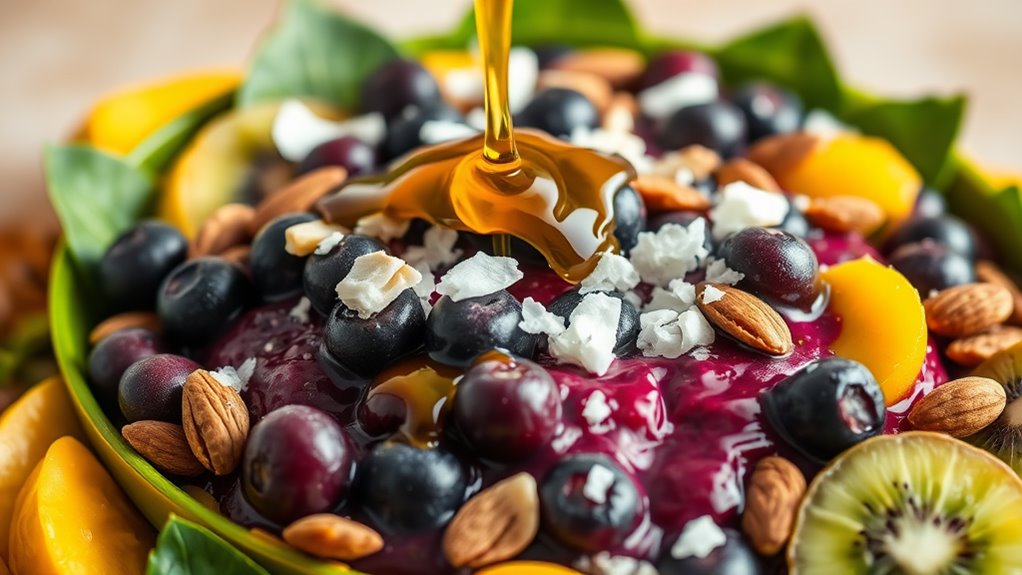Fermented Veggies That Are Surprisingly Simple to Make
Fermenting veggies is surprisingly simple! Start with fresh, seasonal vegetables like cabbage or cucumbers. Just chop, mix with sea salt, and pack them tightly in jars. Let them sit at room temperature for a week. You can add spices or fruits for extra flavor. Keep an eye out for any odd smells or textures, and remember to store your creations properly. There’s more to uncover about flavor combinations and storage tips that’ll enhance your fermentation journey!
Key Takeaways
- Classic sauerkraut involves simply slicing cabbage, adding sea salt, and massaging it to release its juices before fermenting.
- Quick pickled cucumbers are made by soaking sliced cucumbers in a mixture of vinegar, water, salt, and sugar for about an hour.
- Use fresh, seasonal vegetables, sea salt, and purified water for easy and effective fermentation.
- Adding spices like coriander seeds or fresh herbs can create diverse flavors without complicated steps.
- Monitor fermentation progress and store in airtight jars to maintain freshness and enjoy at your own pace.
The Basics of Fermentation
While you might think fermentation is just another culinary trend, it’s actually a time-honored method for preserving vegetables and enhancing their flavors.
When you embark on your journey with DIY fermented veggies, you’re not just creating a snack; you’re connecting with ancient practices that have nourished communities for centuries.
The magic happens through beneficial bacteria that thrive in an anaerobic environment. As you chop your favorite vegetables, envision how the natural sugars will transform during fermentation.
Think of this process as a dance—each ingredient playing its part in a beautiful symphony of taste and texture. Trust the process, and embrace the tangy goodness that awaits.
You’ll find that fermentation isn’t just science; it’s an intimate craft, filled with delightful health benefits that enhance your overall well-being.
Essential Tools and Ingredients
To successfully embark on your fermentation adventure, you’ll need a few essential tools and ingredients that set the stage for delicious results.
Start with clean glass jars, ideally quart-sized, which allow for easy monitoring of your veggies. A sturdy cutting board and sharp knife make chopping a breeze, while a mixing bowl helps combine your ingredients. Don’t forget about a fermentation weight or even a clean stone to keep your veggies submerged in brine.
When it comes to ingredients, fresh, seasonal vegetables are a must, as they’re packed with flavor and nutrients. You’ll also need salt—sea salt or kosher salt works best—along with water, which should be purified or filtered. Additionally, it’s important to maintain the right fermentation temperature to achieve the best flavor and texture for your veggies.
With these tools and ingredients at hand, you’re well on your way to creating delicious fermented delights!
Easy Fermented Vegetable Recipes
Ready to get started with some easy fermented vegetable recipes?
You’ll love making classic sauerkraut or quick pickled cucumbers, both simple and delicious. Fermentation not only enhances flavor but also adds valuable health benefits to your homemade creations.
Let’s explore how you can whip these up in your own kitchen!
Classic Sauerkraut Recipe
Making your own classic sauerkraut at home is easier than you might think. Start with a fresh head of cabbage and slice it thinly. Sprinkle in some sea salt and massage the cabbage until it releases its natural juices—this step is crucial for fermentation.
Pack the mixture tightly into a clean jar, ensuring the liquid covers the cabbage completely. You can add caraway seeds or juniper berries for extra flavor if you like.
Cover the jar, leaving it at room temperature for a week or so. Taste it—once it’s tangy enough for your liking, transfer it to the fridge.
You’ll love how this simple process brings vibrant, crunchy sauerkraut to your meals, enhancing flavors and gut health alike.
Quick Pickled Cucumbers
If you’re craving a crunchy, tangy snack that’s quick to prepare, quick pickled cucumbers are the perfect solution. These delightful bites pack a zesty punch and are ready in no time. All you need are fresh cucumbers, vinegar, water, and a sprinkle of salt and sugar.
| Ingredient | Quantity | Purpose |
|---|---|---|
| Cucumbers | 2 medium | Base of the pickles |
| Vinegar | 1 cup | Adds tanginess |
| Sugar & Salt | 2 tbsp each | Balances flavors |
Simply slice the cucumbers, mix the ingredients, and let them soak for about an hour. You’ll enjoy a crisp, refreshing treat perfect for snacking, sandwiches, or salads. Dive into this vibrant world of flavor!
Flavor Enhancements and Variations
When you’re fermenting veggies, adding spices can create unique flavor profiles you’re sure to love.
Fresh herbs can also brighten up your ferments, making them even more vibrant and delicious.
Don’t forget to experiment with fruit additions; a touch of sweetness can elevate the whole experience!
Spices for Unique Flavors
How can you elevate the flavor of your fermented veggies? By adding spices, you unlock a world of unique and exciting tastes!
Think about incorporating fragrant coriander seeds for a subtle citrus touch, or maybe a dash of cumin for warmth and earthiness. If you’re feeling adventurous, try adding crushed red pepper flakes for a little kick.
Don’t forget about the classic flavors of black pepper or even smoked paprika, giving your veggies a nostalgic twist.
You can even experiment with star anise or fennel seeds to bring a hint of sweetness.
Herbs to Brighten Up
Adding herbs can take your fermented veggies to another level of brightness and freshness. Imagine the vibrant kick of dill in your pickled cucumbers or the earthy warmth of thyme entwining with your carrots.
Fresh cilantro can add a zesty twist, while a sprinkle of basil can evoke summer vibes—all in your jar! Try experimenting with rosemary for a bold, aromatic profile, or mint for a refreshing touch.
Simply toss in a handful during the fermentation process, and let the magic happen. You’ll discover new dimensions to your creations, making each bite a delightful experience.
Don’t shy away from mixing different herbs; it’s a beautiful way to personalize your dish and create something that speaks to your palate.
Fruit Additions for Sweetness
To elevate the flavor profile of your fermented veggies, consider incorporating fruits for a touch of natural sweetness.
Fruit not only enhances taste but also adds beautiful color and complexity. Here are some delightful options to try:
-
Apples – Their crisp sweetness balances well with tangy veggies.
-
Pineapple – Adds a tropical flair that’ll brighten your jars.
-
Beets – Their earthy sweetness can deepen the flavors without being overpowering.
-
Grapes – Perfect for a juicy burst that’ll surprise your taste buds.
Experimenting with these fruits can create unique combinations that’ll make your fermentation journey even more intimate and enjoyable.
Troubleshooting Common Fermentation Issues
While fermenting veggies is a rewarding endeavor, it can sometimes lead to unexpected challenges. If you notice an unusual odor or a slimy texture, don’t panic. These can be signs of spoilage, so trust your instincts and toss it if you’re unsure.
Cloudiness in your brine is often harmless, but if it’s accompanied by mold, it’s time to start over. Don’t forget about bubbles—an indication your veggies are active and alive.
If you want a tangier taste, extend your fermentation time a bit. And remember, temperature matters! Keeping your jars in a consistent, cool spot helps avoid drastic issues. Additionally, always use delicious fermented recipes to ensure you’re on the right track for fermentation success.
Embrace these hurdles as part of your fermentation journey—they’re all learning opportunities waiting for you.
Storing and Enjoying Your Fermented Veggies
Once your fermented veggies are ready, proper storage ensures you can enjoy their vibrant flavors for weeks to come. Here’s how to keep that deliciousness intact:
-
Seal Them Up: Use airtight jars to prevent air exposure.
-
Chill Them Down: Store in the fridge; cooler temps slow fermentation and enhance flavors.
-
Check Regularly: Look out for any off smells or colors; trust your senses.
-
Share the Love: Gift jars to friends and family—it’s a delightful way to spread joy!
When you’re ready to savor them, toss a handful into salads, blend them into dressings, or just enjoy them straight from the jar.
You’ll find they add a tangy twist to nearly every meal!





